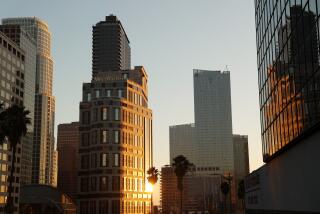Old Pasadena Thanks Parking Meters for the Change
- Share via
Consider the parking meter, a civic piggybank in all its ubiquitous glory.
In auto-obsessed Southern California, it is often despised. Seen as a threat to pocketbook and personal freedom. Scorned by drivers looking to go where they want, park where they need to and keep their cars plopped down on city streets as long as necessary.
But there is one place where the parking meter gets good love: Pasadena, where it is heralded as a savior.
The reason becomes clear to anyone strolling through Old Pasadena, one of the region’s most walkable and well-appointed shopping districts, thanks to an unusual plan for using meter money specifically for street improvements. Merchants say that all the quarters, dimes and nickels pumped into the meters and then reinvested in Old Pasadena helped to usher in change.
A 21-block district, Old Pasadena has been transformed over the last decade from a moribund place known as the city’s skid row into something both special and profitable. It now bustles with people, restaurants and high-end shops. The district’s metamorphosis is underscored by rising sales tax revenue, which reached nearly $140 million last year, a sevenfold increase since 1990.
“We’ve come a long, long way,” said Marilyn Buchanan, a longtime property owner in the district. “This might seem silly to some people, but if not for our parking meters, it’s hard to imagine we’d have the kind of success we’re enjoying.... They’ve made a huge difference.”
In the 1980s and early ‘90s, businesses and residents in Old Pasadena were focused on reinjecting some verve into the neighborhood, which in the early 1900s was the center of Pasadena’s commercial and civic life. Decisions to preserve the district’s historic architecture sparked the change, grabbed the headlines and eventually helped attract businesses such as Crate and Barrel, Banana Republic and Saks Fifth Avenue.
Far less heralded was Old Pasadena’s decision to leverage its parking. There were no meters on Old Pasadena streets then. Drivers could park and leave their cars for two hours. Many did, particularly those who worked in the neighborhood. They tended to gobble up good parking spots near their jobs, leave their cars for a couple of hours, then move to another choice parking spot to avoid getting a ticket. The result: Finding parking in Old Pasadena was tough, and there were few good spaces for shoppers and no real benefit for businesses.
That changed when a group of local merchants agreed with a proposal from Pasadena City Hall to install meters. The merchants agreed, in 1993, on one condition: Instead of going into the general fund, as it does in most cities, all money from the parking meters would be kept in Old Pasadena and used to improve the streets, sidewalks and alleyways there.
“At first it was a struggle to get people to agree to the meters,” Buchanan recalled. “But when we figured out the money would stay here, that the money would be used to improve the amenities, it was an easy sell.”
Old Pasadena put up about 700 meters and used them aggressively, charging $1 per hour in most cases. Unlike parking meters in many Southern California cities, which stop collection at 6 p.m. and don’t charge on Sundays, most Old Pasadena meters operate seven days a week, until 8 p.m. Sunday through Thursday and until midnight on Fridays and Saturdays.
Over the last five years, the meters have pumped $6.4 million into Old Pasadena upgrades. Each year, nearly 40% of the money pays down debt on a $5-million bond that jump-started streetscape beautification with improvements such as sidewalk widening and the conversion of decrepit alleyways into walkable areas lined with brick and ivy.
The leftover money pays for a constant round of improvements: trees, benches, well designed street signs, sidewalk steam cleaning and a private security force.
“This is just such a creative way to pay for making a public space better, and it’s working fantastic,” said UCLA professor Donald Shoup, who researches how parking affects urban landscapes and has studied Old Pasadena. Shoup’s research found that Pasadena was the only city in the region dedicating meter money to a specific neighborhood; he believes the system may be unique nationally.
“The streets and sidewalks, their look, their cleanliness, the walkability -- it’s about as good as it gets,” Shoup said. “Compare it to some of the shopping areas in Los Angeles like Melrose and Westwood, where the sidewalks are narrow and buckled and there’s black spots and chewing gum all over.... These kinds of things seem like they are small details, but they are very important to how successful you are at attracting people. All you’ve got to do is spend a little time out there to see the difference.”
Interviews with walkers and shoppers in Old Pasadena seemed to confirm Shoup’s belief. After parking her white Range Rover near Colorado Boulevard on a recent day, Safia Muhamed put a few quarters in a meter and started walking away to give the district a once-over.
“This place, it’s perfect really,” said Muhamed, searching for an available storefront for a small retail business she hopes to start. “They’ve kept the buildings and the streets well. That makes it so attractive. People are walking around because they like the way it looks and feels. It’s something you just don’t see here in Los Angeles. As a driver, I don’t mind paying more for what you have here. I tell you what: For this, I will pay.”
If you have a question, gripe or story idea about driving in Southern California, write to Behind the Wheel, c/o Los Angeles Times, 202 W. 1st St., Los Angeles, CA 90012, or send an e-mail to [email protected].



